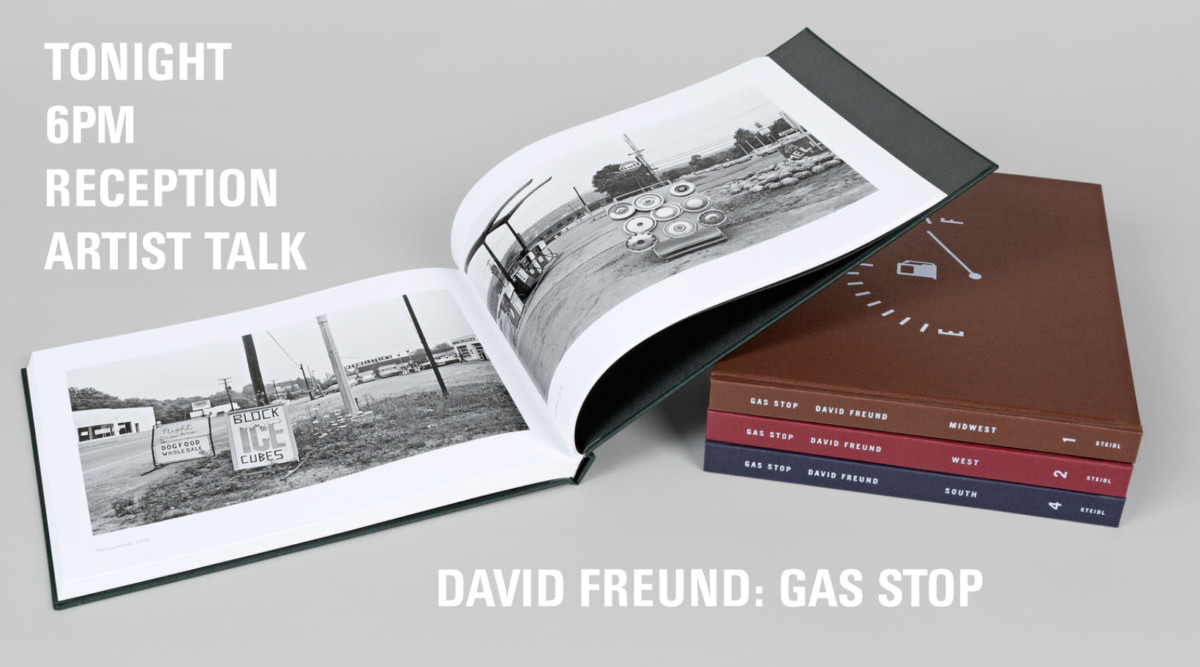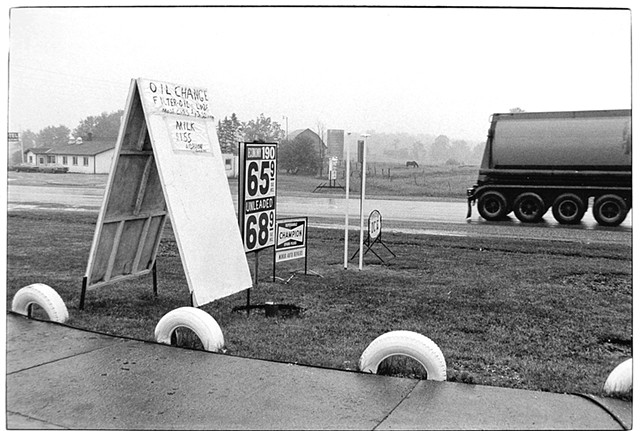
David Freund: Gas Stop
David Freund: Gas Stop 1978-1981
The Lipani Gallery
March 1–March 31, 2017
Reception: Wednesday, March 22, 2017, 6–7 pm
Artist Talk: 7–8pm
Curator: Stephan Apicella-Hitchcock
Fordham University is proud to present David Freund: Gas Stop, a sampling of twenty-seven black & white photographs pulled from a much larger investigation made between 1978 to 1981.
In the twentieth century any American driver or passenger would likely stop at a gas station weekly, not just for gas. Then, gas stations were also oases offering food and drink, car repairs, directions, telephones, maps and, importantly, bathrooms. Yet, beyond appreciation as architectural novelties, they and their offerings have been little photographed.
From 1978 to 1981, David Freund looked at the culture, architecture and landscape of gas stations in more than forty states. The photographs show customers and workers interacting, gassing up, or just hanging out. Architecture and signage, both corporate and vernacular, reach out to passing drivers.
Gas Stop presents the designed or natural landscaping seen at stations, and the regional landscapes that hold and surround them. Sparking recognition and recollection, the photographs, accrue as elements in a nonlinear narrative of automotive America.
Of more than 200,000 gas stations in the United States at the time of his project, today about half are gone, especially full service ones. Such stations and their offerings exist now mostly in memory and in this work.
David writes:
On the first morning of an intended photographic project, outside of my motel was a gas station from which I photographed a dark and rolling tanker truck as its four black tires passed a line of four half-buried white tires. In the misty distance was a grazing horse, framed by the back of the truck. In front of the station was a large, hand-lettered sign advertising milk, and across the road a small, local motel. As someone later commented, “These are about everything.”
The painter Miles Forst once described gas stations as a place to go to fill up your tank and shut off your brain. That morning, however, I became aware of gas stations as a locus for many elements that characterize America. And whether stopping in or hanging out, people in motion are often around to enliven and propel the narrative.
From that moment, looking out from and looking in at gas stations became my new project, which in the end entailed travel to forty-seven states and stops at thousands of stations. All provided discoveries. —David Freund
David Freund Photography
View his forthcoming book on Steidl Books
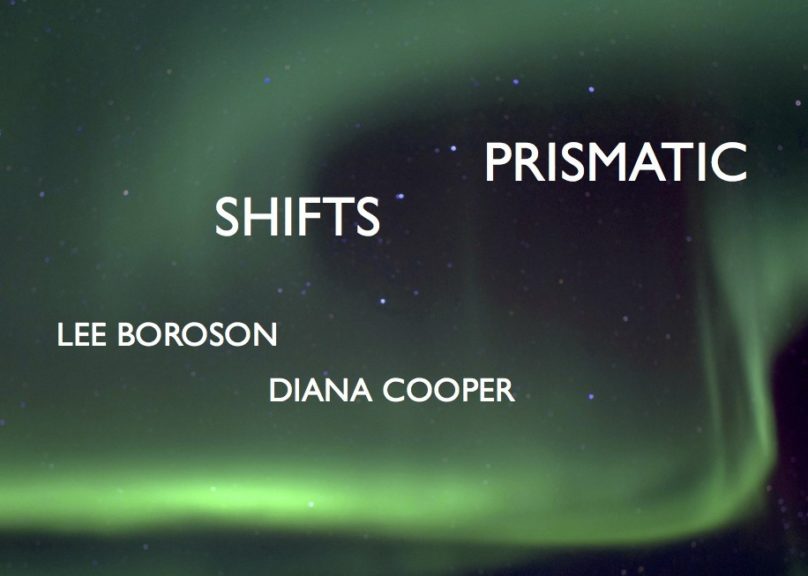
Prismatic Shifts
Prismatic Shifts
Curator: Carleen Sheehan
The Ildiko Butler Gallery
February 22—March 31, 2017
Artist Reception Friday, February 24, 6–8
PRISMATIC SHIFTS will feature site-specific works by artists Lee Boroson and Diana Cooper, working in collaborative engagement with each other’s work and the space surrounding the gallery. Both artists were inspired by the physical space of the Butler Gallery itself, which, with it’s glassed-in front wall and small lense-like windows onto 60th Street, functions as both a vitrine to showcase work and as a prism that reflects and refracts the activities taking place outside it. Both artists share an inclination for engaging and altering our perception of environments in simple yet innovative ways, and they plan to construct artworks that will connect visually to the architecture and activity of both the Lowenstein lobby and the street outside, underscoring the fluidity of our perception of the built and natural worlds, and the ways in we make connections and generate meaning through visual language.
LIVING OFF CAMPUS: Gentrification, Housing Rights, and Social Justice
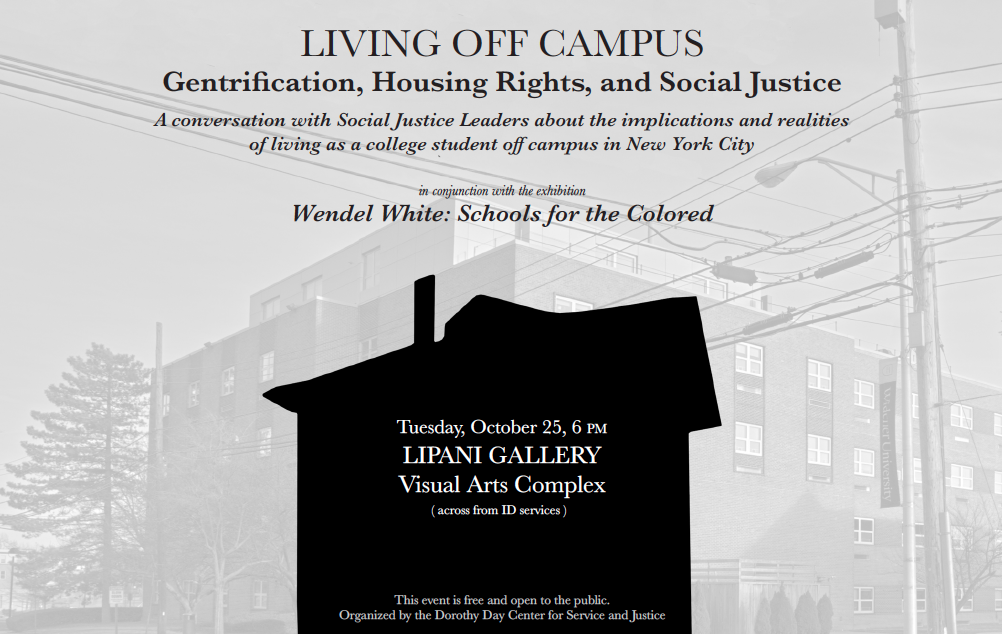
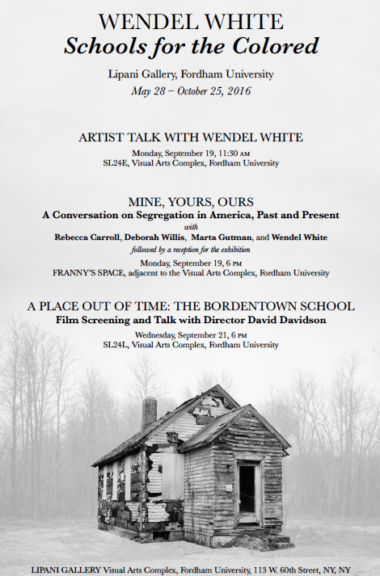
Wendel White: Schools for the Colored
Wendel White
Schools for the Colored
Lipani Gallery, Fordham University
May 28 – October 25, 2016
Artist Talk with Wendel White
Monday, September 19, 11:30 am
SL24E, Visual Arts Complex, Fordham University
Mine, Yours, Ours
A Conversation on Segregation in America, Past and Present with
Rebecca Carroll, Deborah Willis, Marta Gutman, and Wendel White
followed by a reception for the exhibition
Monday, September 19, 6 pm
Franny’s Space, adjacent to the Visual Arts Complex, Fordham University
A Place Out of Time: The Bordentown School
Film Screening and Talk with Director David Davidson
Wednesday, September 21, 6 pm
SL24L, Visual Arts Complex, Fordham University
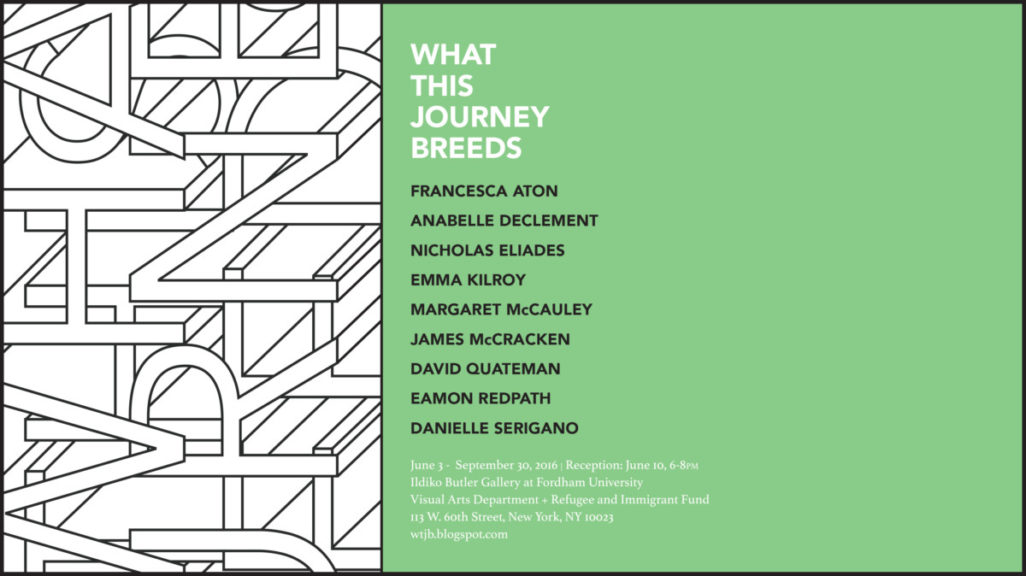
What This Journey Breeds
Ildiko Butler Gallery – Fordham University
Visual Arts Department + Refugee and Immigrant Fund
June 3 – September 30, 2016
Reception: June 10, 6-8PM
What This Journey Breeds, presented by the Visual Arts Department of Fordham University and the Refugee and Immigrant Fund (RIF), is an exhibition of multi-disciplinary work created by Visual Arts students with concentrations in Graphic Design, Painting & Drawing, Photography, Architecture, and Film & Video.
As its name suggests, What This Journey Breeds describes the culmination of this unique group of students’ formative engagement with RIF and the Brooklyn Grange. Over the course of the 2015-16 academic year, Fordham students have been working closely with RIF, participating from support group meetings, to interviews, and to hands-on volunteering in the gardens and at the University. In tandem to these experiences, they have been making work in response to their relationship with the asylum seekers, investigating themes of displacement, vulnerability, loss, and above all, hope. Most significantly, this journey revealed to its participants that atrocities can occur at every scale and knows no geographic, political, or cultural boundary.
Organized by Anibal Pella-Woo, Amie Cunat and Carleen Sheehan. Participating Artists: Francesca Aton, Anabelle Declement, Nicholas Eliades, Emma Kilroy, Margaret McCauley, James McCracken, David Quateman, Eamon Redpath, and Danielle Serigano.
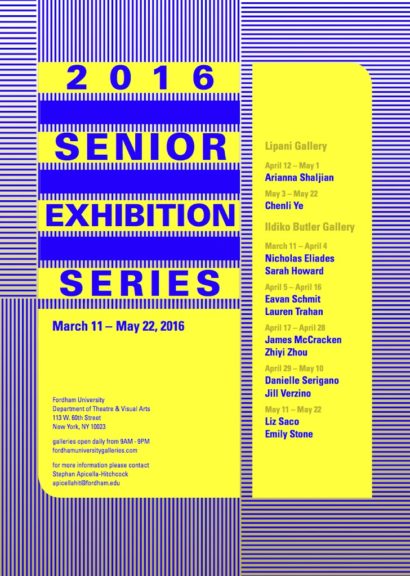
2016 Senior Exhibitions
A Tour of FCLC’s Art Galleries | Fordham Observer
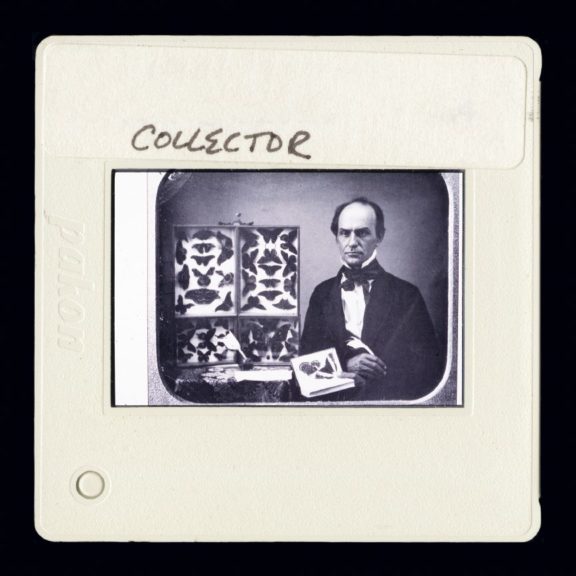
THE EVIL GENIUS OF A KING
THE EVIL GENIUS OF A KING
A new project by Matthew Bakkom
Curator: Stephan Apicella-Hitchcock
October 14–December 6, 2015
Reception: Thursday, October 29, 6–8 pm
Fordham University’s Lipani Gallery
113 West 60th Street, New York, NY 10023
fordhamuniversitygalleries.com
The Lipani Gallery is located in the Visual Arts Complex in the street level of the university
Image caption: Collector, 12.5” x 12.5” mounted Inkjet print, 2013
The Department of Theatre and Visual Arts at Fordham University is pleased to present THE EVIL GENIUS OF A KING, a new project by Matthew Bakkom. This exhibition brings together fifty-two enlargements made from a deaccessioned art and art history slide collection from St. Cloud University in Minnesota.
The artist was given this teaching collection—approximately ten thousand 35mm slides—and utilized the material to generate a survey through the history of art; however, a survey that entirely avoided traditional classification according to eras and movements, rather interpreting the collection based on chance juxtapositions and natural affinities. The 12.5” square images are installed in a continuous band that encircles the Lipani Gallery. Connections arise at times from linguistic puns between caption information on the slide mount, from formal relationships between images, and from associations between image content.
One might consider the sequence of imagery not unlike a plan for a discursive lecture in support of a curious theory. In this respect, Bakkom’s working methodology and objectives are illuminating:
“I proceeded to draw them [the slides] one by one from the large boxes into which they had been cast. The very first that came to hand was an image that inspired the title of the show. From this point of departure I combed through the remainder, sifting and winnowing in the hopes of discovering what exactly the evil genius of a king might be. I invite the audience to join me in this speculation, one that is pieced together through a series of new photographic documents that aspire to grasp and share specific moments of our shared aesthetic and technological past.”
THE EVIL GENIUS OF A KING is a subjective inquiry into the trajectory of art history, as well as homage to a now obsolete teaching technology. The shift from the first image in the exhibition, the boardroom of the Whitney Museum of art, to the second, the Tower of Babel, sets the tone for what is to follow. Across fifty-two slides, art historical notions pertaining to style, influence, and tradition are circumvented, yielding a visual narrative that is alternately critical, poignant, and at times quite humorous.
Stephan Apicella-Hitchcock, 2015
(for more information please email: apicellahit@fordham.edu)
Matthew Bakkom (B.1968) is an Assistant Professor at the University of Wisconsin-Madison. Since the early 1990’s he has been active as an artist and organizer in the U.S. and Europe. His first book, New York City Museum of Complaint was published in 2009 by Steidl-Miles.
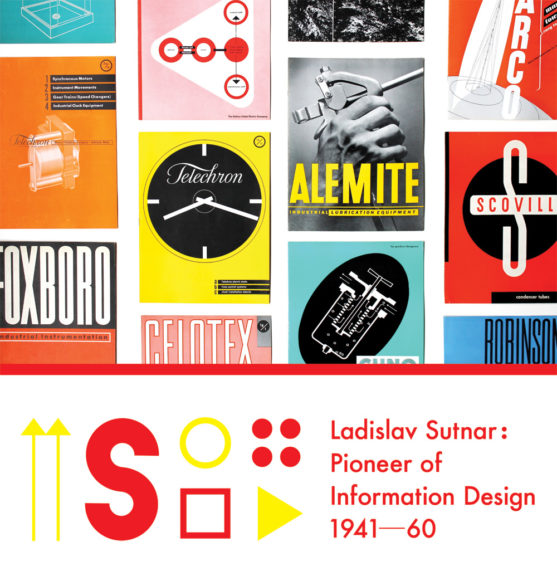
Ladislav Sutnar: Pioneer of Information Design
Ladislav Sutnar: Pioneer of Information Design
The Ildiko Butler Gallery
October 5 – December 14
Talk by Greg D’Onofrio on Wednesday, Oct 14th at 6:30pm
Closing Reception on December 8th at 6pm
The dissemination and configuration of information is more important than ever with the internet, mobile gadgets and social media as the default means of communication, commerce and research. Data organization and accessibility has its roots in the work of graphic designer, Ladislav Sutnar (1897-1976). From 1941–60, Sutnar, who had settled in New York City in 1939 after migrating from Czechoslovakia, served as the art director for F.W. Dodge Corporation’s Sweet’s Catalog Service, producers of a wide range of industrial catalogs. Sweet’s catalogs brought together into one source plumbing, electrical, and building supplies which were marketed to the architecture and engineering trades. Along with his team of researchers, writers and designers (including Director of Research Knud Lönberg-Holm), Sutnar transformed the complex language of product information into clear, concise, and easy to use visual communication. The attributes of these ground-breaking catalogs are the precursor to what we now refer to as information design.
Sutnar’s designs were rooted in the Modernist and Constructivist ideas of the European Avant Garde. His well-defined visual systems and standardized ways of navigating information integrated form and content into dynamic visual units. Sutnar controlled the flow of information using geometric shapes, symbols, blocks of color, thick rules, logical navigation aids, indexes and typographic hierarchy.
This exhibition is a rare opportunity to see over fifty Sweet’s catalogs along with other published work by Sutnar relating to information design. The examples show how careful analysis and fundamental problem solving can revolutionize new standards of form and function. Sutnar’s pioneering work is as relevant today as it was more than 74 years ago. He was a master at making the complex simple, an arduous challenge that continues to resonate today.
Ladislav Sutnar: Pioneer of Information Design is curated by Patricia Belen & Greg D’Onofrio – graphic designers, writers and educators. Please visit thisisdisplay.org for more information. Sponsored by The Visual Arts Department, Fordham University, organized by Abby Goldstein, Associate Professor with assistance from Margaret McCauley, BA 2017.
